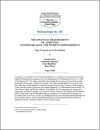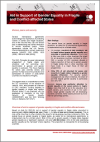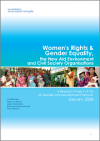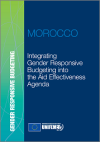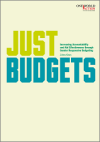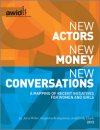FOUND 26
This reference tool handbook, available in English, French and Arabic, is the sixth in a series produced by the Inter-Parliamentary Union (IPU) which seeks to advance parliament's own capacity to make a positive impact on the budget, and to equip parliament, its members and parliamentary staff
This is the eighth in a series of briefing documents for the media from the RELAY programme. RELAY works with Southern print and broadcast journalists to communicate the findings of academic research in an accessible way. This issue focuses on the links between taxation and governance. Copyrights.
The paper provides a comprehensive overview and guide to complex issue of linkages between aid and gender equality.
The present study is a contribution to mark the 10th anniversary of the adoption of UNSCR 1325, and provides an overview of DAC members' funding targeted to gender equality in fragile and conflict-affected states.
The report "Gender Equality, the new aid environment and CSOs" was researched and written by the Gender & Development Network (GADN) because of a growing concern about the fast changing aid structures, such as direct budget support, pooled funding schemes for supporting civil society and other f
The Paris Declaration on Aid Effectiveness (PD) commits donors and partner countries to reform aid management and delivery in order to strengthen its development outcomes.
Well-being gender budgeting (WBGB) experiences use a multidimensional approach for planning and budgeting combining the Capability Approach along with gender responsive budgeting.
This research was carried out by Ms Nalini Burn, GRB Expert under the programme "Integrating gender responsive budgeting into the aid effectiveness agenda" launched by UNIFEM and the European Commission (EC) in 2008.
This report synthesises findings from a two year research and advocacy programme "Just Budgets" carried out in partnership with four leading African civil society organisations.
The third report in a new research series on resources for women's rights organizing from the Association for Women's Rights in Development, this publication presents the results of our mapping of new donors making major commitments to work with "women and girls", to better understand this trend and


